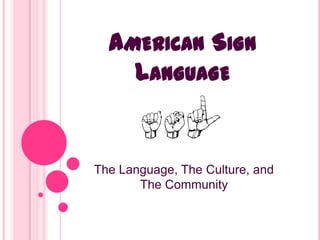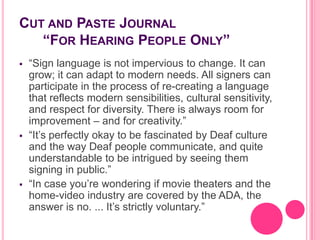ASL Final...One last shot!
- 1. AMERICAN SIGN LANGUAGE The Language, The Culture, and The Community
- 2. A QUICK OVERVIEW: WHAT WE LEARNED ? Many new American Sign Language (ASL) signs ? How the Deaf Culture operates ? Aspects of the Deaf Community ? How to communicate with the Deaf ? How to put our knowledge into play
- 3. THE DEAF CULTURE ? The Deaf do not consider themselves different than the Ą°hearingĄą world ? The Deaf can do everything that hearing people can do ? The term Ą°Hard-of-HearingĄą is no longer used for the Deaf
- 4. THE DEAF COMMUNITY ? The Deaf community is very tight-knit ? Community gatherings and events occur on a regular basis
- 5. DEAF EXPERIENCES ? Deaf Chat ĻC Gathering of Deaf people at a local coffee chat for a chance for many Deaf, hearing, and ASL students to get together and Ą°chatĄą. ? Class with Deaf student ĻC On campus, we attended a class with a Deaf student who uses the aide of an interpreter.
- 6. READER ANALYSIS Rachel: Megan: ? Ą°Empowering Deaf ? Ą°When the Client Consumers Through SignsĄą the Use of Deaf and ? Ą°Spiritual Life and Hearing Interpreter TeamsĄą Mental HealthĄą ? Ą°The Child Who is Deaf ? Ą°Issues and and Hearing ParentsĄą Implications of Deaf ? Ą°Trends and Culture in TherapyĄą Challenges in Teacher Preparation in Deaf EducationĄą
- 7. CUT AND PASTE JOURNAL Ą°FOR HEARING PEOPLE ONLYĄą ? Ą°Sign language is not impervious to change. It can grow; it can adapt to modern needs. All signers can participate in the process of re-creating a language that reflects modern sensibilities, cultural sensitivity, and respect for diversity. There is always room for improvement ĻC and for creativity.Ąą ? Ą°ItĄŊs perfectly okay to be fascinated by Deaf culture and the way Deaf people communicate, and quite understandable to be intrigued by seeing them signing in public.Ąą ? Ą°In case youĄŊre wondering if movie theaters and the home-video industry are covered by the ADA, the answer is no. ... ItĄŊs strictly voluntary.Ąą
- 8. CUT AND PASTE JOURNAL Ą°FOR HEARING PEOPLE ONLYĄą ? Ą°Most Deaf people appreciate a hearing strangerĄŊs interestĄIf you get rebuffed, donĄŊt take it personally. Take it in stride, as a negative learning experience. It happens to all of us.Ąą ? Ą°We believe that deaf children should be exposed to sign language as well as speech, as part of a Total Communication or Bilingual-Bicultural curriculum. They can choose whatever mode they feel comfortable with.Ąą ? Ą°Obviously, not all career possibilities are equally feasible. Everyone has talents. Everyone has limitations. Everyone has abilities. And everyone has disabilities. Nothing is accomplished without risk and sacrifice. We deserve the right to fail as well as to succeed.Ąą
- 9. SIMPLE SIGNS TO KNOW ? Please ? Drink ? Thank You ? More ? Yes ? Finished ? No ? Bathroom ? Food ? Help
- 10. Ą°THANK Ą°PLEASEĄą ģÛ°ŋąŦĄą
- 11. Ą°ģÛ·Ąģ§Ąą Ą°ą·°ŋĄą
- 12. Ą°đó°ŋ°ŋķŲĄą Ą°ķŲļéąõą·°Ąą
- 13. Ą°ēŅ°ŋļé·ĄĄą Ą°đóąõą·ąõģ§ąá·ĄķŲĄą
- 18. RACHELĄŊS DEMONSTRATION ? http://www.youtube.com/watch?v=wpDtA7rmibU MEGANĄŊS DEMONSTRATION ? http://www.youtube.com/watch?v=9HDeEbJyNK8


















